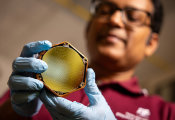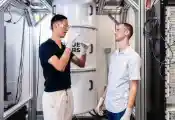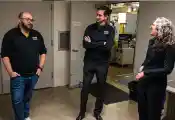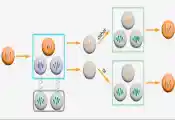URI-Led Study Holds Promise for Advancing Modular Quantum Information Processing
KINGSTON, Aug. 14, 2024 -– In recent theoretical research, a team of physicists, led by University of Rhode Island professor Vanita Srinivasa, envisions a modular system for scaling quantum processors with a flexible way of linking qubits over long distances to enable them to work in concert to perform quantum operations. The ability to carry out such correlated or “entangling” operations between linked qubits is the basis of the enhanced power quantum computing holds compared with current computers. A new paper on their research, co-authored by Srinivasa, Jacob M. Taylor of the University of Maryland and the National Institute of Standards and Technology, and Jason R. Petta of the University of California, Los Angeles, was recently published in the journal PRX Quantum.
“Each qubit in a quantum computer operates at a specific frequency. Realizing the capabilities unique to a quantum computer relies on being able to control each qubit individually via a distinct frequency, as well as to link pairs of qubits by matching their frequencies,” said Srinivasa, director of URI’s Quantum Information Science program and an assistant professor of physics. “As a quantum processor is scaled to larger numbers of qubits, being able to simultaneously achieve both of these operations for every qubit becomes very challenging. In our work, we describe how applying oscillating voltages effectively generates extra frequencies for each qubit in order to link multiple qubits without having to match all of their original frequencies. This allows qubits to be linked while simultaneously allowing each qubit to retain a distinct frequency for individual control.”
However, scaling up a quantum processor by simply adding more and more spin qubits and their associated control circuitry to a single array of qubits is very challenging in practice. The theoretical work by Srinivasa and her colleagues addresses this problem by providing a step-by-step guide that shows multiple ways to entangle spin qubits over long distances with flexibility in matching their frequencies.
The resulting flexibility opens a pathway to semiconductor-based modular quantum information processing, which represents an alternative approach for building many-qubit systems using small arrays of qubits – modules – that can already be made today, and connecting them with robust, long-range entangling links.
While there are many types of qubits and a corresponding variety of ways for them to interact, the researchers chose to study quantum dot-based spin qubits that interact through microwave photons in a superconducting cavity. Quantum dots are atom-like structures created to confine electrons – and other particles used to define qubits – to small spaces within semiconductors and control them individually by applying voltages. Likewise, superconducting cavities are fabricated structures that confine photons but are much larger than quantum dots, with a size set by the wavelength of microwaves.
Recent experiments have demonstrated long-distance links between quantum dot spin qubits using microwave cavity photons. (The first demonstration for two spin qubits in silicon was achieved by co-author Jason Petta’s experimental research group.)
However, tuning all of the qubit and photon frequencies so they precisely match and can exchange energy – a condition called resonance – to establish a link has been a problem even at just the two-qubit level, the paper says. To address this problem, the researchers present a highly tunable approach for linking qubits using microwave photons that does not rely on simultaneous resonance among all original qubit and cavity frequencies.
In their paper, the researchers provide comprehensive guidelines for tailored long-distance entangling links that allow flexibility by making multiple frequencies available for each qubit to become linked with microwave cavity photons of a given frequency, “like multiple keys that can fit a given lock,” Srinivasa said.
Extra frequencies can be generated by applying an oscillating voltage to each spin qubit that moves the spins back and forth in the quantum dots. If this back-and-forth motion is fast enough, two sideband frequencies – one higher and one lower in frequency than the original qubit frequency – are created for each qubit in addition to their characteristic frequency.
The addition of the sideband frequencies results in three ways to tune each qubit into resonance with microwave cavity photons, and consequently nine different conditions under which two qubits can be linked.
This flexibility in resonance conditions would make it much easier to add qubits to a system because they do not need to all be tuned to the same frequency. Furthermore, the nine ways for two qubits to be linked enable several different types of entangling operations to be selected simply by setting the oscillating voltages appropriately, without having to modify the structure of either the quantum dots or the cavity photons.
The versatility in types of entangling links enables an expanded set of elementary quantum operations with which to perform calculations. Finally, the researchers show that their proposed entangling method is less sensitive to leakage of photons out of the cavity than previous approaches, allowing for more robust long-distance links between spin qubits.




































